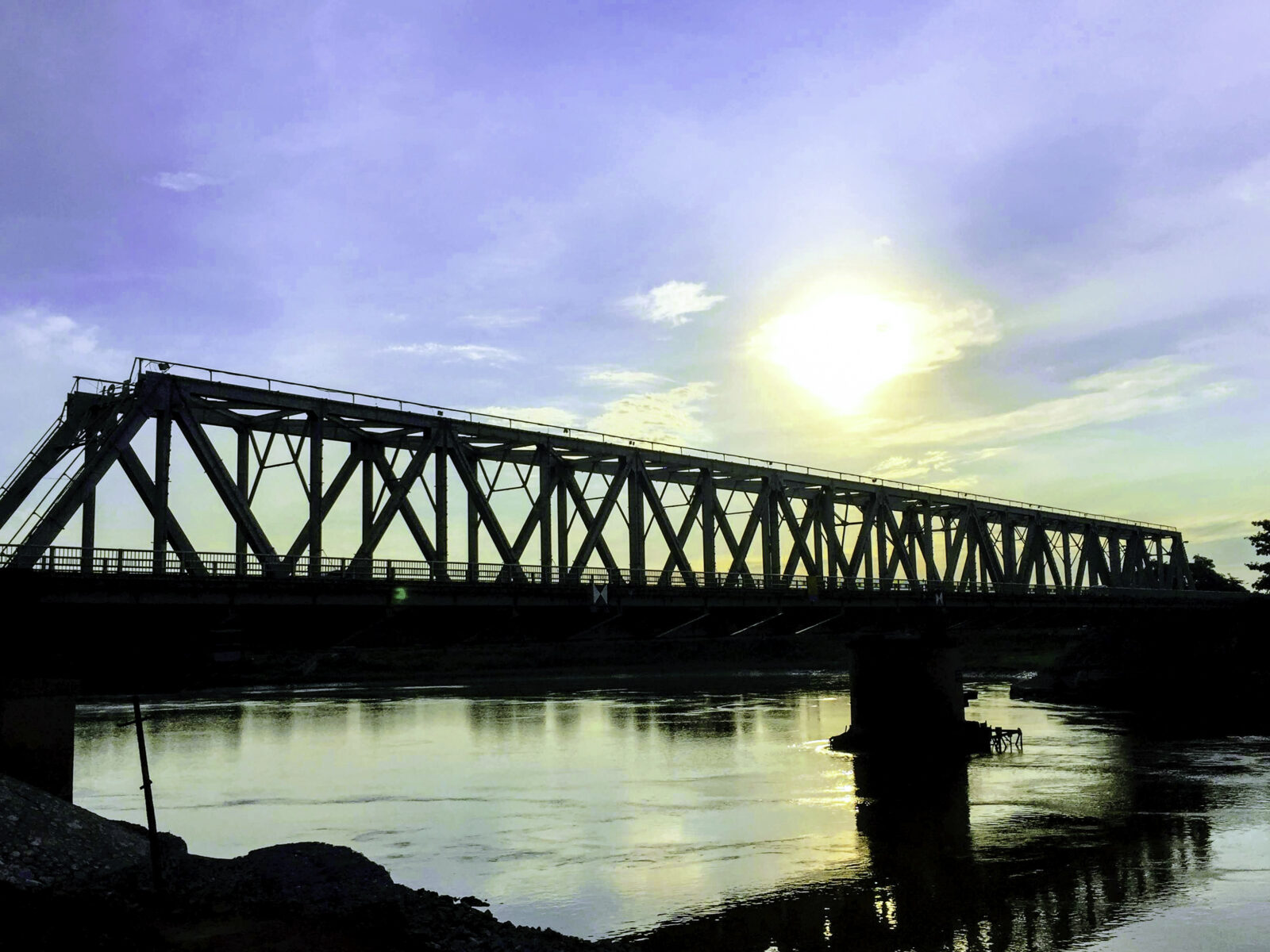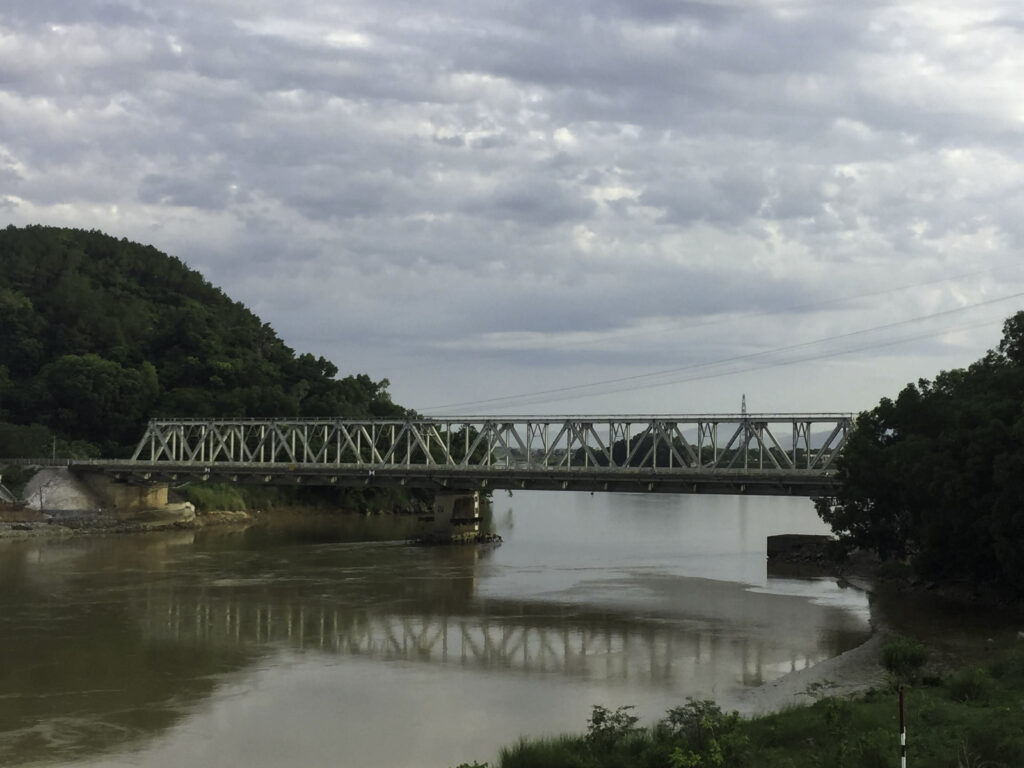Ham Rong Bridge

Four kilometers north of Thanh Hoa city is the Ham Rong Bridge, crossing the Ma River. “Ham Rong” translates to “Dragon’s Jaw,” as the bridge is historically known to Vietnamese. Ham Rong Bridge was constructed in 1964, replacing a previous French-built bridge at the same spot was destroyed by the Viet Minh during the First Indochina War. It was a critical piece of infrastructure during the Vietnam War and one of the very few crystal clear choke points along the supply route between Hanoi 80 kilometers to the north, the port city of Vinh further to the south, and ultimately the beginning of Ho Chi Minh Trail in the western part of the country. At 540 feet long and 56 feet wide, Ham Rong Bridge was built to support both rail and vehicular traffic, which meant that the bulk of material destined to travel down the Trail to the war in the south crossed it. The bridge became one of the most strategic sections of real estate on both sides, and ultimately one of the most heavily defended parts of North Vietnam.
The United States grew obsessed with destroying the Ham Rong Bridge. There just weren’t many quality infrastructure targets quite like it. In the early days of the Rolling Thunder bombing campaign in 1965, the United States Navy and Air Force got to work. In one month, May 1966, US land- and carrier-based aircraft targeted Ham Rong with 128 tons of bombs. Thirty more airstrikes took place between January and March of 1966. There were some hits, but no knockout.
In 1965, the USAF innovated a “floating bomb” especially for the Ham Rong Bridge. According to plan, it would be dropped from a C-130 at distance and float down the Ma River with sensors that would detonate the bomb when it passed underneath the bridge. These floating bombs were massive: 4,000 pounds, with a 500 pound warhead, measuring 8 feet by 3 feet. Superstructure to keep the bombs afloat on the river were also designed. Months of testing, and re-testing, this technology took place in the United States. The goal was to destroy Ham Rong Bridge.
Two Floating Bomb attacks took place in 1966. Neither was successful. On the second try, the C-130 was shot down over a region that was quickly becoming armed to the teeth against America’s air war.

The bridge had become something of an obsession for the North Vietnamese, too. Due to its track record of imperviousness to American technology and air superiority, Ham Rong became a symbol of Vietnam’s defiance and resourcefulness. More antiaircraft artillery, MiGs, and surface-to-air missiles were moved into Thanh Hoa as the war ground on and the USSR began assuming China’s patron and military aid role in the late 1960s. Repairing the bridge and having it up and running within a few days of a successful strike became a national priority. North Vietnam certainly had the labor. But evidently there were more than a few talented engineers in North Vietnam during this time, as the construction of the Ho Chi Minh Trail would also attest.
President Johnson halted Rolling Thunder in 1968. President Nixon resumed bombing in the Linebacker I campaign in 1972, after the Easter Offensive of that same year. By then, the United States deployed new laser-guided bomb technology, and had another go at Ham Rong. On the second try in October 1972, the bridge was hit and destroyed. But it was a bit late. By late 1972, the US withdrawal from Vietnam was in full swing and the momentum was on the North Vietnamese side.
The United States committed 873 sorties, to the loss of 11 aircraft, against Ham Rong Bridge over a seven-year period.
The bridge was rebuilt. But it’s since been replaced with a bridge much larger and more practical and modern, downriver about half a kilometer. Vietnam’s new north-south supply route. The rebuilt Ham Rong Bridge is mainly for the Reunification Express train, local pedestrians, motorbikes, and bicycles. In that sense, today it probably looks and feels the way it did years ago – women going to market, students on bicycles, and workers on 50 cc motorbikes headed to construction sites.
Thanh Hoa province is located at the northern tip of the country’s North Central region, where south and center transform into north. Nghe An province, 140 kilometers to the south, is the birthplace of some of Vietnam’s most heralded leaders and revolutionaries, including Ho Chi Minh himself. The country’s earliest Communist uprisings took place in this part of the country during the French colonial period. Part of the reason for this revolutionary DNA is the region’s miserable weather and hard agricultural conditions. Throughout history, it’s been one of the country’s poorest regions and thus hosted the origin story of Vietnam’s proletariat. The North Central region sees Vietnam’s fewest tourists. Most pass right through. Plus, it’s known for its conservatism and traditional lifestyle. It’s not a modern place.

But history is long. There’s a personality associated with this part of the country that is unmistakable. Pride and even defiance. Despite all the odds: climate, poverty, colonialism, the North Central region produced the leaders that won multiple wars and turned the 20th century on its head. People from Nghe An in particular are in some sense an entitled class in Vietnam. They are history’s purest in the national narrative, having achieved revolutionary consciousness before any other part of the country. Like the larger region, Thanh Hoa included, they don’t supplicate to anyone for anything – resources, attention, or a pat on the back. They don’t care about tourists. They certainly aren’t going to practice their English with and tell Westerners how great they are. This shoulder chip caused some friction in the early days both wars, when this region’s people seized control of new governments in Hanoi to administer the north, and in 1975, a unified Vietnam. Hanoians still bristle when they hear North Central working class accents. They know what’s coming.
So you might not make a lot of friends when you visit Thanh Hoa and the Ham Rong Bridge, but be advised: this is a singular place and it’s worth enjoying on its merits. And a final point on the bridge itself. Lest you think that this is one of the country’s countless forgotten war sites, the small shrine that graces the hilltop on the bridge’s immediate northern side with an absolutely massive Vietnamese flag flying atop a pagoda, well above anything else in the vicinity, reminds you that it’s not.